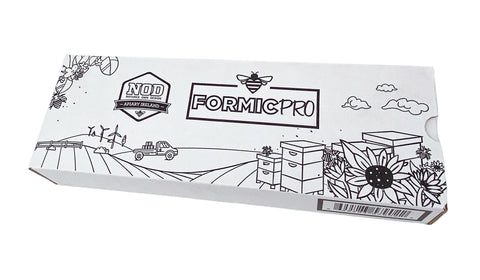Varroa, and the viruses it transmits, is still the number one issue for bees and beekeepers and it's essential we monitor for and if necessary treat for varroa as we head later into the summer.
Monitoring
Monitoring is commonly achieved with a varroa board placed under the open mesh floor (OMF). The board is coated with Vaseline, so that any mites that drop from the hive get stuck and are unable to climb back into the hive. Normally, the board is left for a week and then the varroa can simply be counted on the board. The National Bee Unit (NBU) have a very helpful calculator on the Beebase website to determine the level of varroa and the necessity to treat.
Treatments
There are a number of treatments available for varroa, as bees are livestock and producing food for human consumption, it is essential to use Veterinary Medicine Directorate (VMD) approved treatments only. It's also essential to follow the usage instructions carefully and to treat with the correct dose in the correct way and for the correct amount of time. When used correctly, these treatments are safe and offer a significant reduction in varroa numbers (>90%).

MAQS is a formic acid based treatment for varroa and is the only VMD approved medication that may be used to treat varroa whilst the honey supers remain on the hive. This is useful if a high varroa count is found during the honey flow. MAQS also penetrates the brood cappings and will kill mites within sealed brood.
MAQS is simple and quick to use with two strips being placed above the brood chamber across the frames. The treatment is left for 7 days and then the strips should then be removed and composted. MAQS should only be used on strong hives and additional ventilation is required (see image for options below). The daytime temperature should be between 10oC and 29.5oC for the first 3 days of treatment.
Formic acid may damage metal components within the hive such as runners and ventilation mesh. These can be protected by coating with Vaseline prior to treatment.




Formicpro is a new formic acid-based treatment made by the same manufacturer as MAQS. It has an extended 2-year shelf life so unused strips may be used across 2 seasons.
The treatment regimen is the same as for MAQS with 2 strips used over 7 days. The requirements for additional ventilation and the temperature between 10 and 29.5oC are the same.
Formicpro has not been approved for use with Honey Supers on the hive so these must be removed for the duration of the 7 day treatment.


Apiguard is a thymol (Thyme extract) based product for treatment of varroa. It is provided in foil trays and treatment requires 2 trays per hive. 1 tray is placed above the brood chamber for 14 days, after 14 days a second tray is added and left for a further 14 days to complete the treatment. To ensure sufficient space above the brood frames when treating, an eke or a Super may be used.
The active ingredient, thymol, is unable to penetrate brood cappings hence the 28 day treatment to ensure that varroa both within unsealed brood, on the bees (phoretic) and in sealed brood are killed. As a reminder, worker brood has a 21-day development cycle and drone brood a 24-day development cycle. The 28-days thus ensures the optimal treatment.
To ensure proper treatment, the ambient daytime temperature should be above 15oC. Apiguard has a long shelf-life and so may be used over multiple seasons if there is excess left over.
Medicine Records
As bees are livestock there is a legal requirement to keep medicine records for 5 years showing any treatments applied to your hives. A medicine record card can be downloaded here.
The product used, batch number, expiry date, supplier, amount used and duration of treatment must be noted for each treatment used. The date and disposal route of any unused medicines must also be recorded.

